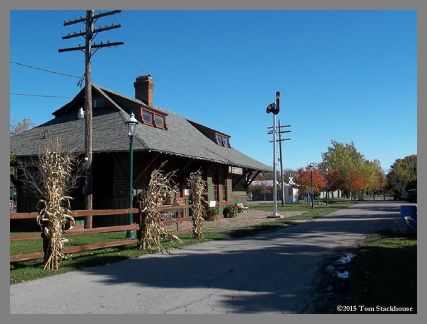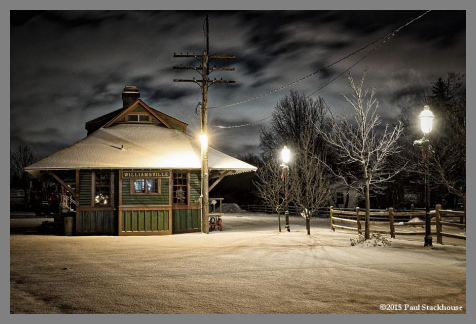| Back to Home Text |
 |
 |
| In 1892, the Lehigh Valley Railroad completed its main line and established a western terminus in Buffa-lo, New York. At the same time, Niagara Falls had begun to flourish as a tourist attraction. The LVRR, wanting to capitalize on the tourist appeal of the cataract and to extend its anthracite coal business to the Midwestern United States, entered an agreement with the New York Central to use the Central’s “Peanut Line” as its route to Niagara Falls. The “Peanut Line,” which began in Canandaigua, and ran through the towns of Clarence, Amherst, and Tonawanda, was used by the LVRR until November 14, 1896. In 1895, officials of the Lehigh Valley Railroad felt that their line would get an economic boost from having its own Niagara Falls route. In the summer of 1895, ground was broken on a 10.5 mile branch line that would bypass Buffalo at Depew, connect with the "Peanut Line" in Tonawanda, and take the LVRR into Niagara Falls, New York, Canada, and the Midwestern U.S. The new branch of the LVRR opened on November 15, 1896 and was made a subsidiary of its parent company. It was called "The Depew and Tonawanda Railroad". |
| The village of Williamsville, New York, a suburb of Buffalo in the town of Amherst, was at the mid - point of the Depew and Tonawanda Railroad. In October of 1896, at a site on South Long Street in Williamsville, construction began on a railroad station designated to monitor passenger and freight business in the town of Amherst. |
| The first Williamsville station agent was a young man named Herbert Tilley. Tilley had been transferred to Williamsville from the Lehigh Valley’s Rochester branch depot in Hemlock, New York where he had also been an agent. With the help of his brother, who was the station agent at the LVRR depot in Cayuta, New York, Herbert Tilley prepared the Williamsville depot for business. When this railroad station opened in November of 1896, it had a staff of three: Tilley and two assistants. This gave the town of Amherst and the village of Williamsville round-the-clock service. On December 10, 1896, the first Lehigh Valley Railroad passenger schedule appeared in the Amherst Bee newspaper. Accounts in the Bee from that period indicate that Williamsville and Amherst residents boarded trains often at the Williamsville depot to take day trips to Niagara Falls and Buffalo, and to travel greater distances to destinations such as Ithaca, New York and New York City. Around 1903, the Depew and Tonawanda Railroad became known as the Niagara Falls branch of the Lehigh Valley Railroad. In this era of rail passenger travel it was nicknamed “The Honeymoon Route”. By this time, according to the Amherst Bee newspaper, the whistles of freight and passenger trains were routinely heard throughout the village of Williamsville. It has been suggested that during the World War I years, young men embarked on journeys of military service through the Williamsville depot. By the 1920s, the town of Amherst had begun modernizing its system of highways. Roads such as Millersport Highway and Wehrle Drive were built in the mid-1920s with materials transported by the Lehigh Valley and loaded onto trucks at the Williamsville depot. In the early 20th century, the Williamsville railroad station was the scene of a number of interesting events. Among them, the first setting of feet on American soil by an immigrant. W. Evelyn Davies of Williamsville recounted this moment in a poem she wrote: |
| How vividly I do recall, this Lehigh Valley Station! T’was here my feet first touched the ground, of my adopted nation. The train pulled in from Canada, our two small tots and me. Nobody else got off that day, how strange it seemed to be. The year was 1924, it seems so long ago. But I still have affection for this old Lehigh Depot. It was our Ellis Island then, my ship a railroad train! Thank you for all you’ve done, to bring it back again! |
| The depot in Williamsville was constructed in 1896 and was the only station on the Lehigh line between Depew to Niagara Falls. There was a three track yard behind the depot, which was manned 365 days a year, serving both passengers and freight. In the late 1890's, Williamsville was a half day's horseback ride from Buffalo, and an even longer ride by stage coach over rutted paths, as there were no smoothly paved roads. Trolley service between the Village of Williamsville and Buffalo appeared some time later. Hence passenger service was important to both the area and to the railroad. At the height of service, one could board a train at the depot to transfer in Depew for Buffalo or points east or west, or continue on to New York City. After the Pennsylvania Railroad opened the tunnels under the Hudson River, one could ride directly into the city rather than to disembark in Jersey City for a ferry trip to Manhattan. The Lehigh Valley was the only railroad coming from the west (New Jersey, Pennsylvania, Ohio) allowed by the Pennsylvania to use the tunnels to the City, since the Pennsy felt that the route of the Lehigh Valley was not competitive. The depot was built in the fashion of mainline stations from Sayre, Pennsylvania to Buffalo, all constructed between 1891 and 1896, with the depot in Williamsville believed to be the last structure completed by the Lehigh Valley Railway before the railroad was absorbed by its Pennsylvania counterpart, the Lehigh Valley Railroad. Only four other depots of this design (three in New York and one in Pennsylvania) are known to be still standing. Passenger service declined with the advent of the automobile, but continued through World War II. By the 1930s, thanks to improvements in the western New York highway system, the automobile had begun to replace the train as the chief mode of travel to Niagara Falls. Going by train to see one of the seven natural wonders of the world quickly fell by the wayside causing local passenger travel on the LVRR’s Niagara Falls branch to decline steadily throughout the 1930s. Often during this pe-riod, Lehigh Valley timetables indicate that Williamsville was a flag stop on an as-needed basis. This meant that a train like the New York to Toronto “Maple Leaf” would only stop to pick up passengers in Williamsville if the station agent on duty “flagged it down”. Otherwise, the passenger train would just rumble past the Williamsville depot. By 1940, local passenger travel on the Niagara Falls branch reached an all-time low. On September 29, 1940, passenger service to Williamsville ceased, and the name "Williamsville" disappeared from LVRR timetables as an official passenger stop. Recollections from some individuals indicate that soldiers joining the military during the second World War, may have started their journey to service at the Williamsville train station. From 1940 until the building was abandoned in 1973, the Williamsville depot would be utilized as a freight station. It continued to serve businesses around its locale and the town of Amherst, most notably the Interna-tional Chimney Corporation on South Long Street. Passenger travel on the entire Lehigh Valley Railroad continued to decline in the late 1940s and throughout the 1950s. By the latter part of this period, the Niagara Falls branch saw limited use as a passenger route. By the late 1950s, the Niagara Falls to Toronto "Maple Leaf" was the only passenger train that passed through Williamsville, usually once or twice a day and either very early in the morning or very late at night. According to some who lived in the village, during this time, the late night Maple Leaf, which came through around 11 o’clock in the evening, was referred to as “Bed Check Charlie.” On February 4, 1961, the "Maple Leaf" made its last run past the Williamsville depot, and passenger travel came to an end on the Lehigh Valley Railroad as a whole. |
| what was once a profitable anthracite hauling railroad was in sight. In 1973, with its business declining along the Niagara Falls Branch, the LVRR abandoned the Williamsville depot and the building began to fall into disrepair. |
| The last day of work on the Lehigh Valley Railroad took place on March 31, 1976. Railroad enthusiasts could be seen that day around the Williamsville depot and other portions of the Niagara Falls branch hoping to catch a glimpse or get a photo of the final train on the LVRR’s once – heralded route to Canada and the Midwestern United States. The following day, April 1, 1976, the Lehigh Valley was merged with six other northeastern American railroads and a new entity, "Conrail," was formed. By February of 1977, the only segment that remained of the 10.5 mile branch line that carried LVRR’s passenger train "The Maple Leaf" and many trainloads of anthracite coal, was from Depew to Williamsville, including "Niagara Junction" in Depew. That section of the branch line from was abandoned by Conrail in 1982 and the tracks were all gone by 1987. The building was sold to International Chimney for storage space by Conrail in 1986 after years of neglect. Water damage had partially collapsed a part of the passenger side of the depot . The Western New York Railway Historical Society acquired the depot from International Chimney in 1990, while at the same time, the land and a quarter mile of right of way between South Long and Cayuga streets were purchased by the Village of Williamsville for a walking and bicycle path named "The Lehigh Valley Memory Trail." Land underneath the building is leased from the Village by the Society. The paving blocks around the depot are not part of the original plan, but were originally part of a cobblestone street in the City of Buffalo, and were obtained by a member from the City for reuse at the Williamsville depot. Reconstruction of the depot initially proceeded at a less than snail's pace, until the building was re-roofed and the dormers rebuilt by volunteers after the late Ken Wiley donated the cost of the shingles. Since then, reconstruction has progressed, including the replacement of all but five windows with glass from the period, replacement of the colored class at the window peaks (following the pattern of the original glass that was found in two windows that had been boarded up inside and out). The depot crew laid the cobbles in the front of the building, which has greatly enhanced the appearance of the structure. |
Web Site Hosting by TRAIN WEB
The WNYRHS, Inc. P.O. Box 416, Buffalo, NY. 14231-0416 is an independent organization and has no affiliation with any other local or national group.
The Society is a fully qualified organization under 501 (C) (3) of the Internal Revenue Code and all donations to the Society are tax deductible.
©Copyright 1999 , WNYRHS Inc. all rights reserved